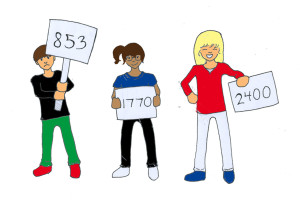Since 2005, the SAT has remained unchanged with a 2400 scoring scale and an essay portion.
However, with an unexpected move, College Board decided to completely overhaul the SAT beginning in the spring of 2016.
The dreaded essay will now become optional, instead of mandatory, while the scoring scale will revert to the old 1600 point scale.
Helping students, the time of the exam will shrink 45 minutes so that the new SAT is only three hours.
“It is time to admit that the SAT and the ACT have become far too disconnected from the work of our high school,” SAT Board President David Coleman stated.
Compared to the old SAT, the new SAT is much more practical and fair with its changes.
The correlation between SAT scores and college success is almost nonexistent. The college GPAs and graduation rates of 33 colleges and universities that made the SAT optional did not differ much from colleges that did require the SAT.
Furthermore, the report concluded that students with good high-school GPAs but low SAT scores did well in college, while those with low high-school GPAs and high SAT scores did not.
Undoubtedly, the SAT is not a predictor of college preparation, and College Board is attempting to confront this concern.
Regarding the individual portions, the writing and reading sections are becoming much more practical. The essay portion will require students to read a passage and explain how the author builds an argument, and while the SAT prompt will be shared in advance, only the passage will change.
Becoming optional, the essay will help significantly in college admissions.
“It’s just like the ACT having the writing section. If you think you can do it well, then go for it,” senior Austin Martin said.
The optional essay will probably prompt many colleges to not require the writing section, while the top-tier colleges can put more weight on the writing and receive more qualified candidates in the admission pool.
Furthermore, the reading section is experiencing a significant overhaul as well.
According to Coleman, the original purpose of the obscure, notorious SAT words were to ensure that nobody could effectively study for the SAT vocabulary.
Unfortunately, it did not adequately reflect the goals of the College Board.
Now, the former arcane SAT vocabulary will be replaced with more day-to-day language with words like “empirical,” which will undoubtedly help more students as they focus on understanding essential words in daily life.
“The reading section has become more useful and practical because it will consist of articles that will be necessary and used in our lives,” freshman Melissa Pregasen said.
The reading prompts are shifting their focus for the better.
Dubbed the “great conversion documents,” documents like the Declaration of Independence and the Federalist Papers will be used in the SAT.
As these documents will force thousands of students to understand the foundations of our country and even the world, the SAT reading prompts have taken a significant stride from useless passages about fish environments.
They will also require using evidence-based responses with specific citations from the passage in the multiple-choice questions. Overall, the reading section has become more conducive to argumentative writing and questioning.
Although the math section does not seem to have as drastic changes as the writing and reading sections, it is also becoming much more interdisciplinary and focused on problem-solving skills. Highlighting that math can be applicable in social sciences, the SAT will question the students’ familiarity with complex equations applied in the sciences and social sciences.
Also, rather than asking to “find x,” more questions will force students to delve into necessary problem-solving and mathematical manipulation techniques.
As these types of reforms may not be implemented in many schools because of time and cost constraints, test takers could see a helpful revival of problem-solving math, not the simple “plug-and-chug.”
Furthermore, as the Washington Post reports, SAT scores in the past show an increase with higher family income as those who make more than $200,000 have a 400-point SAT gap with those who make $20,000.
However, the new SAT better achieves equal opportunity.
With the current SAT, many poor students cannot afford highly-qualified tutors, costly SAT summer programs, and the stack of prep books necessary for the SAT, which skew the test for the affluent.
Now the SAT plans to work with Khan Academy to provide a free online tutoring service. Khan Academy already has 10 million viewers who move at their own pace on a range of topics from calculus to philosophy.
One of the main goals of the new SAT is to make the test reflective of what students learn in school, somewhat similar to the ACT.
Low-income individuals will definitely benefit from the public school services, and free tutoring opportunities should be enough to aid the students in receiving high scores with hard work.
The new SAT is less about how one can game and maniuplate the test, but more about how much one actually knows.
“I think the SAT will become easier because of the new words and the math, which are focusing down to things being taught in class,” Martin said.
In the early 1990s, the SAT acronym changed from meaning the Scholastic Aptitude Test to just the SAT, meaning absolutely nothing at all.
With the new version of the test, the SAT will begin to stand for its true meaning.












